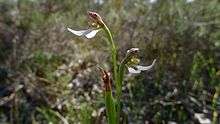Eriochilus dilatatus subsp. undulatus
Eriochilus dilatatus subsp. undulatus, commonly known as the crinkle-leaved bunny orchid,[1] is a plant in the orchid family Orchidaceae and is endemic to Western Australia. It has a common orchid in the wheatbelt and has single narrow egg-shaped leaf with wavy edges and a maroon underside. Up to three dull green, red and white flowers are borne on a wiry flowering stem.
| Crinkle-leaved bunny orchid | |
|---|---|
 | |
| Eriochilus dilatatus undulatus growing in Swan View | |
| Scientific classification | |
| Kingdom: | Plantae |
| Clade: | Tracheophytes |
| Clade: | Angiosperms |
| Clade: | Monocots |
| Order: | Asparagales |
| Family: | Orchidaceae |
| Subfamily: | Orchidoideae |
| Tribe: | Diurideae |
| Genus: | Eriochilus |
| Species: | |
| Subspecies: | E. d. subsp. undulatus |
| Trinomial name | |
| Eriochilus dilatatus subsp. undulatus | |
Description
Eriochilus dilatatus subsp. undulatus is a terrestrial, perennial, deciduous, herb with an underground tuber and a single narrow egg-shaped leaf, 15–20 mm (0.6–0.8 in) long and 2–7 mm (0.08–0.3 in) wide. The leaf has wavy edges and a pale maroon lower surface with greenish streaks. Up to three flowers 10–15 mm (0.4–0.6 in) long and 9–14 mm (0.4–0.6 in) wide are borne on a wiry green flowering stem 100–200 mm (4–8 in) tall. The flowers are greenish with red or mauve markings, except for the lateral sepals which are white. The labellum has three lobes and scattered clusters of pale cream-coloured and maroon hairs. Flowering occurs from April to May and is not stimulated by fires.[1][2][3][4]
Taxonomy and naming
Eriochilus dilatatus subsp. undulatus was first formally described in 2006 by Stephen Hopper and Andrew Brown from a specimen collected in the Wongan Hills and the description was published in Nuytsia.[5] The subspecies epithet (undulatus) is a Latin word meaning "wavy",[6] referring to the edges of the leaves of plants in flower.[2]
Distribution and habitat
The crinkle-leaved bunny orchid is widespread and common in a wide variety of habitats from woodland to granite outcrops from Northampton to near Esperance and inland as far as Mullewa.[1][2][3][7]
Conservation
Eriochilus dilatatus subsp. undulatus is classified as "not threatened" by the Western Australian Government Department of Parks and Wildlife.[7]
References
- Brown, Andrew; Dundas, Pat; Dixon, Kingsley; Hopper, Stephen (2008). Orchids of Western Australia. Crawley, Western Australia: University of Western Australia Press. p. 259. ISBN 9780980296457.
- Hopper, Stephen; Brown, Andrew Phillip (2006). "New and reinstated taxa in Eriochilus" (PDF). Nuytsia. 16 (1): 44–45. Retrieved 23 June 2018.
- Hoffman, Noel; Brown, Andrew (2011). Orchids of South-West Australia (3rd ed.). Gooseberry Hill: Noel Hoffman. p. 226. ISBN 9780646562322.
- Jones, David L. (2006). A complete guide to native orchids of Australia including the island territories. Frenchs Forest, N.S.W.: New Holland. p. 276. ISBN 1877069124.
- "Eriochilus dilatatus subsp. 'Eriochilus dilatatus subsp. undulatus'". APNI. Retrieved 14 July 2018.
- Brown, Roland Wilbur (1956). The Composition of Scientific Words. Washington, D.C.: Smithsonian Institution Press. p. 826.
- "Eriochilus dilatatus subsp. undulatus". FloraBase. Western Australian Government Department of Parks and Wildlife.